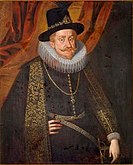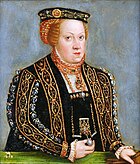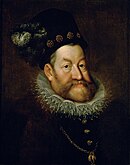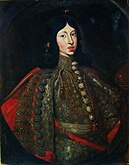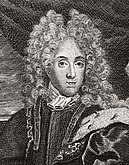Habsburg lower lip

Detail of a marble bust by Paul Strudel , completed in 1695 ( Kunsthistorisches Museum , Vienna )

The Habsburg lower lip (or Habsburg lip ) is the pronounced hereditary lower lip of the Habsburgs . It results from a hereditary overdevelopment of the lower jaw ( "real" progeny ) and tooth misalignment of class III as a result of inbreeding and forms part of the characteristic Habsburg face .
For centuries, members of the Habsburgs had an extremely pronounced lower lip or lower jaw. Gerald D. Hart concludes from a review of images of the Habsburgs on coins and portraits that this jaw misalignment was part of the dominant family inheritance from at least 1440 to 1705. Most paleopathological investigations have been limited to such evaluations of the physiognomy according to artistic representations, which the Habsburgs have found in unusually large numbers over long periods of time. Skeletons were examined for anatomical abnormalities in two studies.
background
There are several hypotheses about the origin. Some already see Rudolf von Habsburg (1218–1291) as having a weakly pronounced Habsburg lower lip, which, however, cannot be proven and should be a legendary claim. According to further assumptions, the pronounced lower lip comes from Johanna von Pfirt (1300-1351), the wife of Albrecht II of Austria (1298-1358). Others lead the lower lip into the 15th century with Albrecht II (1391–1439) or Cimburgis of Masovia , the mother of Emperor Frederick III. , back. The progeny of the last Spanish Habsburg ruler, Charles II (1661–1700), of whose eight great-grandparents six were native Habsburgs and the seventh a Wittelsbacher whose mother was a Habsburg was extremely pronounced . The feature, which was already prominent in his father and grandfather, became so strong that Charles II was considered disfigured and had difficulty speaking and chewing at all. Liselotte von der Pfalz certified her son-in-law Leopold von Lothringen , son of a Habsburg woman, “an Austrian mouth”.
The centuries-long transmission of this hereditary disease within the family can be traced back to the strong dynastic endogamy , which led to marriages of close relatives between 1516 and 1700 during the coexistence of the two lines of the Habsburgs, the Spanish and the Austrian (see loss of ancestry , inbreeding in humans ) . From this, Hans-Joachim Neumann concluded that it was an autosomal dominant inheritance .
Research on this topic has a long tradition and was married to the racial theories and hereditary teachings of the late 19th and early 20th centuries. Victor Haecker wrote in 1911, "[i] n all biological works in which human inheritance is mentioned", "the Habsburg lower lip is cited as a physical characteristic that has been transmitted with particular tenacity through numerous generations." In particular, the racism of the Nazi era set the stage for some publications on the subject. The art historian Heinz Ladendorf judged Wilhelm Strohmayer's comprehensive monograph The Inheritance of the Habsburg Family Type, published in 1937 . A hereditary-physiognomic consideration on a genealogical basis shows that the work is "particularly accessible to the new demands [of the Nazi regime] on scientific work" as one of the "attempts to promote racial and clan studies through image studies".
photos
Cardinal Leopoldo de 'Medici
literature
- Gerald D. Hart: The Habsburg jaw. In: Canadian Medical Association journal. Volume 104, Number 7, April 1971, pp. 601-603, PMID 4927696 , PMC 1930988 (free full text).
- Gerald P. Hodge: A Medical History of the Spanish Habsburgs. As traced in portraits. In: Journal of the American Medical Association . Vol. 238, 1977, pp. 1169-1174.
- Hans-Joachim Neumann : About the origin of the Habsburg family type. In: Sudhoff's archive . Vol. 70, 1986, pp. 77-83, JSTOR 20777033 .
- G. Wolff, TF Wienker, H. Sander: On the Genetics of Mandibular Prognathism. Analysis of Large European Noble Families. In: Journal of Medical Genetics . Vol. 30, 1993, pp. 112-116.
- Zachary S. Peacock, Katherine P. Klein, John B. Mulliken, Leonard B. Kaban: The Habsburg Jaw - Re-examined. In: American Journal of Medical Genetics. Part A. Vol. 164, 2014, No. 9, pp. 2263-2269 ( doi: 10.1002 / ajmg.a.36639 ).
supporting documents
- ↑ The exact paleopathological diagnosis is not without controversy, most recently Zachary S. Peacock, Katherine P. Klein, John B. Mulliken, Leonard B. Kaban: The Habsburg Jaw - Re-examined. In: American Journal of Medical Genetics. Part A. Volume 164, 2014, No. 9, pp. 2263-2269 ( doi: 10.1002 / ajmg.a.36639 ).
- ↑ Gerald D. Hart: The Habsburg jaw. In: Canadian Medical Association journal. Volume 104, Number 7, April 1971, pp. 601-603, PMID 4927696 , PMC 1930988 (free full text).
- ^ For four Habsburgs buried in Prague (negative finding): E. Vicek, Z. Smahel: Contribution to the origin of progeny in middle European Habsburgs. Skeletal roentgencephalometric analysis of the Habsburgs buried in Prague. In: Acta chirurgiae plasticae. Volume 39, 1997, No. 2, pp. 39-47 ( abstract ); for Johanna von Österreich (positive result): Donatella Lippi, Felicita Pierleoni, Lorenzo Franchi: Retrognathic maxilla in “Habsburg jaw”. Skeletofacial analysis of Joanna of Austria (1547-1578). In: Angle Orthodontist. Volume 82, 2012, No. 3, pp. 387-395, here p. 388 ( doi: 10.2319 / 072111-461.1 ); Stefano Colagrande, Natale Villari, Felicita Pierleoni, Domizia Weber, Gino Fornaciari, Donatella Lippi: Teeth of the Renaissance: Apaleopathological and historic-medical study on the jaws of the Medici Family. In: Journal of Forensic Radiology and Imaging. Volume 1, 2013, pp. 193-200, here p. 194 ( doi: 10.1016 / j.jofri.2013.07.004 ).
- ↑ Dirk Van der Cruysse: Being a Madame is a great craft. Liselotte of the Palatinate. A German princess at the court of the Sun King. From the French by Inge Leipold. 7th edition, Piper, Munich 2001, ISBN 3-492-22141-6
- ^ This is what Neumann postulates for the time since the 13th century: About the origin of the Habsburg family type. In: Sudhoff's archive . Volume 70, 1986, pp. 77-83. The genetic hypothesis has also been disputed, see EM Thompson, RM Winter: Another Family with the 'Habsburg Jaw'. In: Journal of Medical Genetics . Volume 25, 1988, pp. 838-842, here p. 839.
- ↑ Spiegel Online: Inbreeding formed the face of the famous royal family , Dec. 2019
- ↑ Victor Haecker: The family type of the Habsburgs. In: Journal for inductive descent and inheritance. Volume 6, 1911, No. 1/2, pp. 61–89, here p. 61 .
- ^ Heinz Ladendorf : § 6. Historical image studies. In: Annual reports for German history . Volume 13, 1937. It refers to Wilhelm Stromhmayer: The inheritance of the Habsburg family type. A hereditary physiognomic consideration on a genealogical basis (= Nova Acta Leopoldina . New series. Volume 29). German Academy of Natural Scientists, Halle 1937.






